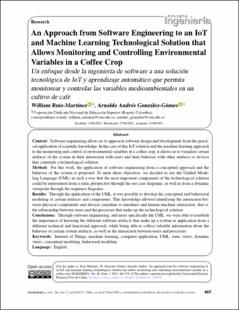| dc.contributor.author | Ruiz-Martínez, William | |
| dc.contributor.author | González-Gómez, Arnaldo Andrés | |
| dc.date.accessioned | 2023-09-01T22:48:50Z | |
| dc.date.available | 2023-09-01T22:48:50Z | |
| dc.date.issued | 2021-09-19 | |
| dc.identifier.citation | APA | spa |
| dc.identifier.issn | 0121-750X | spa |
| dc.identifier.uri | https://repositorio.cun.edu.co/handle/cun/4173 | |
| dc.description.abstract | Context: Software engineering allows us to approach software design and development from the practical application of scientific knowledge. In the case of this IoT solution and the machine learning approach
to the monitoring and control of environmental variables in a coffee crop, it allows us to visualize certain
artifacts of the system in their interaction with users and their behavior with other artifacts or devices
that constitute a technological solution.
Method: For this work, the application of software engineering from a conceptual approach and the
behavior of the system is proposed. To meet these objectives, we decided to use the Unified Modeling Language (UML) in such a way that the most important components of the technological solution
could be represented from a static perspective through the use case diagrams, as well as from a dynamic
viewpoint through the sequence diagrams.
Results: Through the application of the UML, it was possible to develop the conceptual and behavioral
modeling of certain artifacts and components. This knowledge allowed identifying the interaction between physical components and devices (machine to machine) and human-machine interaction, that is,
the relationship between users and the processes that make up the technological solution.
Conclusions: Through software engineering, and more specifically the UML, we were able to establish
the importance of knowing the different software artifacts that make up a system or application from a
different technical and functional approach, while being able to collect valuable information about the
behavior of certain system artifacts, as well as the interaction between users and processes. | eng |
| dc.format.extent | 14 Paginas | spa |
| dc.format.mimetype | application/pdf | spa |
| dc.language.iso | eng | spa |
| dc.subject.ddc | Ingeniería y operaciones afines | spa |
| dc.title | An Approach from Software Engineering to an IoT and Machine Learning Technological Solution that Allows Monitoring and Controlling Environmental Variables in a Coffee Crop | eng |
| dc.type | Artículo de revista | spa |
| dcterms.audience | Estudiantes, docentes, investigadores, comunidad académica. | spa |
| dc.contributor.researchgroup | AXON | spa |
| dc.description.researcharea | Innovación Tecnológica | spa |
| dc.identifier.eissn | 2344-8393 | spa |
| dc.relation.references | M. Rossainz-López, Diseño orientado a objetos, México D.F., México: Universidad Autónoma de Puebla, 2012.
↑466 | spa |
| dc.relation.references | B. Boehm, “A view of 20th and 21st century software engineering,” in 28th Int. Conf. Soft. Eng. (ICSE ’06),
Shangai, China, May 2006. https://citeseerx.ist.psu.edu/viewdoc/download?doi=10.1.1.
97.4717&rep=rep1&type=pdf ↑466 | spa |
| dc.relation.references | IEEE, IEEE Guide to Software Design Descriptions, Piscataway, NJ, USA: IEEE, 1993. ↑466 | spa |
| dc.relation.references | C. Larman, UML y patrones, Madrid: Pearson, 2003. ↑467 | spa |
| dc.relation.references | J. Rumbaugh, I. Jacobson, and G. Booch, El lenguaje unificado de modelado: manual de referencia, Madrid:
Addison Wesley, 2000. ↑467 | spa |
| dc.relation.references | L. Ramírez, “Diseño de una arquitectura para redes de sensores con soporte para aplicaciones de detección de
eventos,” Doctoral Thesis, Universidad Politécnica de Valencia, Valencia, Spain, 2012. https://riunet.upv.
es/bitstream/handle/10251/15152/tesisUPV3764.pdf ↑469 | spa |
| dc.relation.references | N. D. Castro C, L. E. Chamorro F, and C. A. Viteri M, “Una red de sensores inalámbricos para la automatización
y control del riego localizado,” Revista de ciencias agrícolas, vol. 33, nº 2, pp. 106-116, Aug. 2016. http://dx.
doi.org/10.22267/rcia.163302.57 ↑469 | spa |
| dc.relation.references | K. E Kendall and J. E Kendall, Analisis y diseño de sistemas, Mexico D.F., México: Prentice Hall, 2011. ↑470 | spa |
| dc.relation.references | E. Rozic and S. Herzovich, UML y desarrollo de software orientado a objetos, México D.F., México: Universidad
de San Andrés, 2016. ↑470 | spa |
| dc.relation.references | R. Yeh and P. Zave, “Specifiying Software Requirements,” Proc. IEEE, vol. 68, no. 9, pp. 1077-1085, 1980.
https://doi.org/10.1109/PROC.1980.11806 ↑470 | spa |
| dc.rights.accessrights | info:eu-repo/semantics/closedAccess | spa |
| dc.subject.proposal | Internet of Things | eng |
| dc.subject.proposal | Machine learning | eng |
| dc.subject.proposal | Computer application | eng |
| dc.subject.proposal | UML | spa |
| dc.subject.proposal | Static views | eng |
| dc.subject.proposal | Dynamic views | eng |
| dc.subject.proposal | Conceptual modeling | eng |
| dc.subject.proposal | Behavioral modeling | eng |
| dc.type.coar | http://purl.org/coar/resource_type/c_2df8fbb1 | spa |
| dc.type.coarversion | http://purl.org/coar/version/c_ab4af688f83e57aa | spa |
| dc.type.content | Text | spa |
| dc.type.driver | info:eu-repo/semantics/article | spa |
| dc.type.redcol | http://purl.org/redcol/resource_type/ART | spa |
| dc.type.version | info:eu-repo/semantics/acceptedVersion | spa |
| dc.rights.coar | http://purl.org/coar/access_right/c_14cb | spa |

